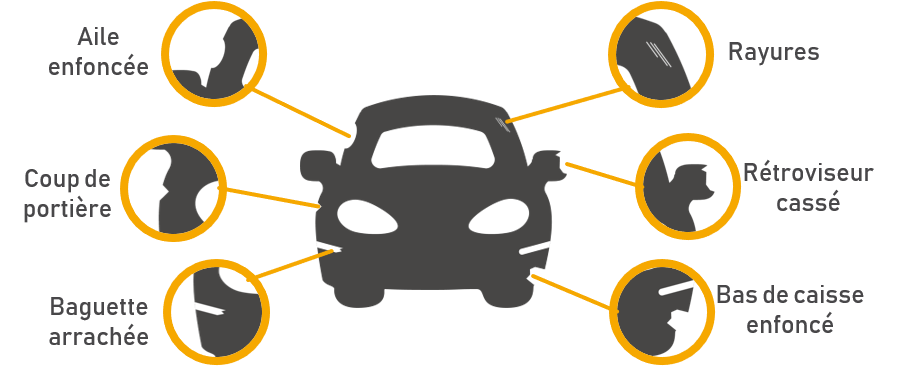A significant cost for the company
At the end of a long-term rental contract, return costs represent a variable expense item. At the end of the contract, they increase the TCO by 3 to 6%, oscillating between €600 and €900 (Dekra estimate). SesamLLD, a union of long-term rental companies, estimates that these unpredictable costs affect 95% of the 300,000 vehicles examined each year, and that on average 9 damages are noted per vehicle. Colossal, return costs are the first source of complaints from rental companies (OVE), embodying an endless battle between protesting against overestimated repair costs and denouncing the damage caused to the vehicle.
To arbitrate differences in perception, rental companies have established a “standard state of return” which describes the normal wear and tear of a vehicle according to its operating law and which sets the limit of what is acceptable to rental companies. This SesamLLD document describes, among other things, that the size of a €1 coin limits the size of acceptable holes and dents on the bodywork; that the scratches on the bumper must not exceed 5cm, those on the rearview mirror 3cm; and that the tread depth of the tires must not be less than 5mm.
This standardization confirms the possibility of billing the customer for the slightest deviation. In return, rental companies have implemented deductibles spread over the entire duration of the rental contract. The customer then finances in installments the risk of returning an abnormally damaged vehicle. Although reassuring, this system will not pay the price of the devaluation that the user generates on his vehicle.
Useful tips to avoid costs
Pay particular attention to the classics of expensive restitution costs such as:
smooth tires, cracked windshields, scratched rims, lost hubcaps, peeling paint, missing duplicate keys, holed seats, dented bodywork, etc. Physical, aesthetic and above all visible, this damage can be repaired in advance, and the return costs anticipated.
The reduction in return costs is spread over the entire duration of the contract . When choosing the type of financing, you should look objectively at what your activity will imply on the use of the vehicle. For example, the purchase option may prove more advantageous for utility vehicles driving on construction sites. On the other hand, a regularly serviced vehicle will cost less than a final bill for repair costs. For example, the company can ask each employee to send a photo of their vehicle annually and to commit to making the necessary repairs. Thanks to preventive communication and a system of monetary rewards (or not) challenging drivers on vehicle maintenance, this dynamic will encourage employees to get involved in maintaining good general condition.
The FATEC solution: JUST REPAIR
To support companies in this process, FATEC has set up a “Just Repair” service. “Doctor of bobology”, Just Repair is a service which focuses on the repair of summary bodywork damage not covered by insurance. Scratches, broken rearview mirrors, rubbing against a parking wall, etc. : there are as many opportunities to cause damage without an identified third party as there is a chance of being billed at the end of the contract. Regular maintenance will allow repair costs to be spread over time as the damage occurs and to return a vehicle to better condition.

PROCESS FOR OPTIMIZING REFURBISHMENT COSTS
The second part of this service consists of a meticulous check of the consistency of the restitution documents . Vehicles, even when maintained, may still be subject to sometimes unjustified return fees due to estimation errors or carelessness. The experts from the FATEC technical platform will then reconcile 3 documents: the return report, the post-return expert report and the rental company's invoice taking into account the excess and the dilapidation, and check the concordance of the elements.
Experts go through everything with a fine-tooth comb. Are the discount, smart repair package and obsolescence grid clauses stipulated in the contract systematically applied? Do the times billed for labor, straightening and painting correspond to the manufacturers' scales? Are the elements tolerable by the standard state of restitution respected (supporting photos)? Are the elements of the invoice exactly identical to the elements noted on the restitution report? By tracking down all errors in the restitution process, the second expertise can reduce the initial bill by up to 40%. A factual and detailed report is then provided to the customer to enable them to file a complaint and negotiate with the rental company.
Finally, when the vehicle is visibly damaged, repairs can be anticipated by carrying out a pre-return visit a few months before the end of the contract. By sending photos of their vehicle to FATEC experts, the driver will then be directed to approved bodybuilders, who will use reused parts in the event of repairable elements. In this case, the customer minimizes the risk of being overcharged during the return procedure and returns his vehicle in better condition.
“Our key words are control and advice. We check all the experts' estimates, to provide the customer with a fair opinion on the return of their vehicle ” comments Jérémy Olinger, restitution referent at FATEC Group.


